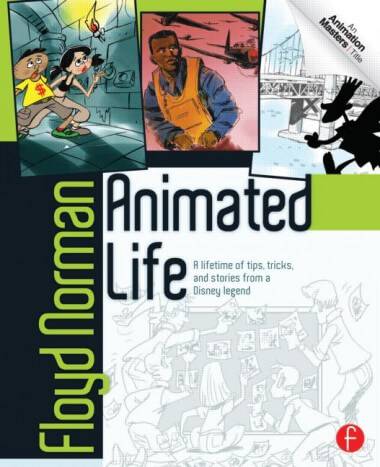Floyd Norman’s ‘Animated Life’ – Book Review
 Animated Life: A Lifetime of Tips, Tricks, Techniques and Stories from an Animation Legend
Animated Life: A Lifetime of Tips, Tricks, Techniques and Stories from an Animation Legend
Author: Floyd Norman
Publisher: Focal Press (Animation Masters Series)
Animation is one of those creative industries that, on its surface, makes a great deal of sense – while at times hugely competitive and not immune to recession, it continues to be a huge component of entertainment, advertising and even education. Just when it seems things are drying up for those who plug away at it, something comes along, and while some (with premature visions, perhaps, of helming their own series or major feature) may grouse at the banality of yet another corporate commission, as a way of paying the bills a lot of us can reasonably concede we’ve lucked out, somewhat. As with every industry, however, moments of ennui, self-doubt and second guessing our path can rear their heads, and in taking stock of who we are and where we’re going it can be beyond helpful to hear the stories of others who’ve come before and gone the distance.
Floyd Norman is certainly a man who knows his stuff in this regard; An animation career of over sixty years at Hanna Barbera, Disney and Pixar with films including Sleeping Beauty, The Jungle Book, Toy Story 2, Monsters Inc, The Hunchback of Notre Dame and Mulan dotted about his track record serve as irrefutable credentials. This creates a potential concern in the disparity between a decades-long career at several of the animation world’s biggest powerhouses and the perceivably more humble kind the book’s readership might find themselves embarking on. Said concern is eschewed fairly early on, as this is not a book about working at a major studio as much as an informal guide to being the best at whatever career in the animation world one chooses to embark upon.

Floyd Norman
As with many Focal Press titles, the book is an effective combination of anecdotal recollections and hands-on advice. In exploring the practicalities of animation, key areas explored include story development, story art, idea development, character work and, rather refreshingly, how to both handle and effectively apply criticism. Additional highlights include a look back at the early, crucial roles of women in animation against a wholly different societal landscape, advances in racial politics within the industry, the effectiveness of collaboration (Norman’s time with Leo Sullivan at the helm of their first studio is explored all-too-fleetingly), respect for the communication within the hierarchies of production, the dangers of entitlement and the importance of empathy.
While the book is certainly broader in approach than the average tips’n’pointers textbook, one unexpected drawback is that the autobiographical elements beg to be expanded on: The stories, highlights and overall journey of Norman’s career and firsthand experience within the industry would make for an incredibly satisfying read in and of themselves, in a book twice or three times the length. That being said, their use as a framework for imparting technical, informational and general industry advice is largely effective, even when at times it reads a bit like having two books on the go at the same time. The headspace one finds oneself in when reading about animation from a societal and cultural perspective isn’t necessarily the same for the learning and application of practical advice. Norman’s joyfulness of tone is really what serves as a crucial reminder that, while this is at times an intimidating and laborious business, a positive spirit and enthusiasm for what’s being achieved at the end of the day will spur you on no end. In short, Animated Life is a valuable book not just for those following directly in the footsteps of the Floyd Normans of the world, but for those in all walks of animation that might take comfort from his story’s possibly unexpected relatability.
Items mentioned in this article:


